#b des fashion design
Explore tagged Tumblr posts
Text
Fashion Designing Course Duration and Career Scope Explained

Have you always found yourself drawn to trends, fabrics, and the creative chaos of styling? If fashion is more than just a hobby and you’re thinking of turning your passion into a thriving career, understanding the academic journey ahead is your first step. From course duration and syllabus details to career opportunities, here’s a deep dive into what a fashion designing degree in India truly entails and why Alliance University is one of the best places to start.
Why Fashion Designing?
Fashion is a dynamic blend of art, technology, and business. As consumer preferences shift and sustainability becomes more central, the need for innovative fashion professionals is greater than ever. That’s why there’s been a noticeable surge in students exploring fashion designing courses after 12th. They’re not just chasing glamour, they're embracing an industry with real influence and vast career options.
Understanding the B.Des Fashion Design Program
A popular choice for students passionate about fashion is the B.Des Fashion Design program. At institutions like Alliance University, this undergraduate program offers a comprehensive blend of creative exploration, technical training, and industry exposure.
Let’s break down the core components:
Fashion Designing Course Duration
The fashion designing course duration is of four years, divided in eight semesters. During this period, students are taken from foundational concepts to specialized skill sets. The progression includes:
Year 1: Fundamentals of design, color theory, and fashion history
Year 2: Introduction to pattern-making, garment construction and textiles
Year 3: Digital design, sustainable fashion, styling, and portfolio development
Year 4: Internships, final collection development, and industry projects
This structured timeline ensures that students are job-ready by the time they graduate equipped with both knowledge and real-world experience.
Fashion Designing Course Syllabus: What You’ll Learn
An essential part of any design program is its syllabus. The fashion designing course syllabus at Alliance University is meticulously designed to cover both theory and practice. Here's what students typically explore:
Key B.Des Fashion Design Subjects:
Fashion Illustration
Pattern Making and Draping
Textile Science and Surface Ornamentation
Apparel Manufacturing Processes
CAD (Computer-Aided Design)
Fashion Marketing and Merchandising
Trend Forecasting and Consumer Behavior
Sustainable Design Practices
Fashion Photography and Styling
Fashion Portfolio and Collection Development
This variety ensures students receive a holistic education from sketch to runway.
Fashion Designing Course Eligibility
If you’re wondering about fashion designing course eligibility, the good news is that it’s accessible to a wide range of students. Typically, eligibility criteria include:
Completion of 10+2 (any stream – Science, Commerce, or Arts) from a recognized board
A flair for creativity, visualization, and innovation
Passing the university’s entrance exam or portfolio review (depending on institution)
At Alliance University, aspiring students can expect a smooth and transparent admissions process that values both academic background and creative potential.
Career Scope After a Bachelor's Degree in Fashion Designing
Now let’s get to the exciting part of career opportunities. After completing a bachelor's degree in fashion designing, students are well-equipped to step into multiple sectors within the fashion industry.
Popular Career Paths:
Fashion Designer – Create original clothing and accessory lines
Fashion Stylist – Style models and celebrities for shoots, events, and campaigns
Textile Designer – Design patterns for fabrics used in apparel or interiors
Visual Merchandiser – Design in-store experiences and window displays for brands
Fashion Illustrator or Photographer – Work with magazines, brands, or e-commerce
Trend Analyst or Fashion Forecaster – Predict upcoming trends and consumer behavior
Fashion Entrepreneur – Launch your own label or design studio
Sustainable Fashion Consultant – Focus on ethical and eco-conscious fashion solutions
Thanks to a well-rounded curriculum and internship support, students from Alliance University often find themselves landing placements with leading brands, fashion houses, and design consultancies.
Why Alliance University Stands Out
If you’re looking for a fashion designing university in India that prioritizes both creativity and career-readiness, Alliance University is a strong contender. It offers:
curriculum is Industry-relevant
World-class faculty and guest lectures from fashion professionals
On-campus design studios and innovation labs
Portfolio-building and fashion show opportunities
Strong internship and placement support
While there may be many institutions on the list of top 10 fashion designing colleges in India, Alliance University’s commitment to holistic, hands-on learning makes it a standout choice for any aspiring fashion designer.
Final Thoughts
A bachelor’s degree in fashion designing is more than just a course, it's the beginning of a lifelong creative journey. With the right foundation, the right mentors, and the right exposure, your passion can evolve into a career that’s both fulfilling and future-ready.
If you’re serious about stepping into the fashion world, investing in the right education is your first and most important move. Alliance University offers the tools, environment, and guidance you need to shape your creativity into impact.
So, are you ready to design your future?
#fashion designing course after 12th#fashion designing course syllabus#fashion designing course duration#top 10 fashion designing colleges in india#b des fashion design
0 notes
Text
Crafting Fashion Futures: Bachelor of Design - Fashion Design Course Specializations
The world of fashion is ever-evolving, with new trends and technologies shaping the industry daily. To thrive in this dynamic field, aspiring designers need a robust education that provides both a strong foundation and opportunities for specialization. The Bachelor of Design in Fashion Design at Alliance University offers a comprehensive program designed to equip students with the skills and knowledge necessary for a successful career in fashion.
Why Choose Alliance University?
As one of the premier fashion schools in Bangalore, Alliance University stands out for its exceptional curriculum, experienced faculty, and state-of-the-art facilities. Recognized among the best colleges for fashion designing in Bangalore, the university offers a learning environment that fosters creativity and innovation.
Bachelor of Design in Fashion Design: Course Overview
The Bachelor of Design in Fashion Design program at Alliance University is tailored to cover all essential aspects of fashion design, from fundamental principles to advanced techniques. This program is ideal for those looking to make their mark in the fashion industry, providing a blend of theoretical knowledge and practical skills.
Core Specializations in Fashion Design
1. Textile Design:
- Explore the intricacies of fabric creation and manipulation. This specialization focuses on understanding various textiles, their properties, and how they can be used innovatively in fashion.
2. Apparel Design:
- Delve into the world of garment construction. Learn about pattern making, draping, and sewing techniques to create stunning apparel.
3. Accessory Design:
- This specialization covers the design and creation of accessories such as jewelry, bags, and footwear, adding the perfect finishing touches to any fashion ensemble.
4. Fashion Illustration and CAD:
- Develop skills in sketching and using computer-aided design (CAD) software to bring your fashion ideas to life with precision and creativity.
5. Fashion Marketing and Merchandising:
- Learn the business side of fashion, including how to market and merchandise fashion products effectively.
Advantages of Studying at Alliance University
- Experienced Faculty: Learn from industry veterans who bring real-world experience and insights into the classroom.
- Modern Facilities: Benefit from access to cutting-edge labs, studios, and design software.
- Industry Exposure: Gain valuable experience through internships, workshops, and collaborations with leading fashion houses.
- Comprehensive Curriculum: The program combines traditional techniques with contemporary practices, ensuring students are well-prepared for the industry.
Why Study Fashion Design in Bangalore?
Bangalore is a thriving hub for fashion and design, making it an ideal location for fashion education. Studying fashion design in Bangalore offers numerous advantages, including access to industry events, networking opportunities, and a vibrant cultural scene.
Cost and Fees
Understanding the cost of education is crucial for prospective students. The fashion designing courses in Bangalore fees at Alliance University are competitive and reflect the high quality of education provided. Detailed fee structures can be obtained directly from the university’s admissions office.
Career Opportunities
Graduates of the Bachelor of Fashion Design program at Alliance University are well-prepared to enter various roles in the fashion industry, such as:
- Fashion Designer: Create original clothing, accessories, and footwear.
- Textile Designer: Develop innovative fabrics and patterns.
- Fashion Illustrator: Visualize and sketch fashion concepts.
- Fashion Merchandiser: Plan and promote fashion products.
- Costume Designer: Design costumes for film, theater, and television.
Conclusion
The Bachelor of Design in Fashion Design at Alliance University is more than just a degree; it’s a pathway to a vibrant and successful career in the fashion industry. As one of the best fashion designing institutes in Bangalore, the university offers a curriculum that is both comprehensive and specialized, preparing students to excel in various facets of fashion design. If you're passionate about fashion and looking to craft a successful future in this dynamic field, enrolling in one of the best fashion designing courses at Alliance University is a significant first step. Explore your creativity, develop your skills, and get ready to make your mark in the world of fashion design.
#b des fashion design#clothing design courses#bachelor of fashion design#fashion designing schools in bangalore#fashion institute in bangalore#fashion design course india#bdes fashion design
0 notes
Text
The Design Village (TDV) stands at the forefront of design education in India, offering a unique and immersive learning experience for students aspiring to shape the world of interior design, fashion design, and product design. With a keen focus on fashion forecasting 2025 and creative trends 2025, TDV ensures its students are prepared to lead and innovate in these rapidly evolving fields. If you are passionate about transforming ideas into reality, now is the perfect time to apply. TDV has opened its admissions for the academic session 2025–2026, and here’s everything you need to know about their courses, fees, and the exciting creative opportunities that await you.
0 notes
Text
What is the scope for a BSc in Psychology?
A B.Sc in Psychology has a lot of scope in India because of the increasing need for mental health professionals. Graduates can take up a career in clinical settings, counselling environments, schools or in organizational psychology. As counsellors, mental health workers, and human resources specialists, many students continue on to their chosen careers. Further studies like a master’s in psychology can lead to specializations like clinical, or neuropsychology.
A B.Sc in Psychology, offered by Rishihood University focuses on creating leaders for a mental health impact. They combine traditional psychology with modern practice to prepare the students for different career opportunities. Rishihood stresses the importance of real-world experience and so their graduates are ready for the job market.
It is so versatile; it is applicable in any school, hospital, corporate sector, and NGO. Psychology careers need practical exposure, and internships are the key to successful psychology careers. The programs at Rishihood University supply students with theoretical knowledge and hands-on skills and, students studying at this institute are ready to work in mental health in future.
You can contact us by
Phone: +91 7669916629
Email: at [email protected]
Website: https://rishihood.edu.in/contact/
Visit us: at NH-44 (GT Road), Near Bahalgarh Chowk, Delhi NCR, Sonipat, Haryana – 131021
#bba finance#bba job opportunities#bba vs bcom#bachelor of design#b design#b des course#b design course#bachelor of fashion design
0 notes
Text

Woxsen University offers an innovative B.Des Fashion Design program that combines creativity with practical skills, equipping students to excel in the fashion industry. This course emphasizes hands-on learning, guiding students through various aspects of design, from concept to execution. With experienced faculty and modern facilities, Woxsen provides a comprehensive curriculum tailored to industry needs, preparing graduates for successful careers in fashion design and related fields.
0 notes
Text
Your Guide to B.Des & B.Arch Courses in Kerala: Top Colleges, Admission Procedures, and Program Details
DC School offers a comprehensive guide to pursuing Bachelor of Design (B.Des) and Bachelor of Architecture (B.Arch) programs in Kerala. Whether you're interested in a B.Des course in Vagamon, Trivandrum, or across Kerala, or exploring B.Arch colleges and admission procedures, our platform provides in-depth information to help you make informed decisions.
Bachelor of Design (B.Des) Programs: DC School highlights premier B.Des courses available throughout Kerala. Our guide includes:
B.Des Interior Design Colleges: Find top institutions offering specialized interior design programs. Learn about the curriculum, faculty, and facilities that make these colleges stand out.
Bachelor of Design in Kerala: Explore a list of the best B.Des colleges across Kerala. We cover institutions offering various specializations, including product design, graphic design, and fashion designing.
Top B.Des Colleges in Trivandrum: Discover leading colleges in Trivandrum that offer exceptional B.Des programs. Our guide provides details on their courses, campus life, and admission requirements.
Bachelor of Design Specializations: Whether you’re interested in fashion designing, product design, or graphic design, our guide details the top B.Des colleges in Kerala for each specialization.
Bachelor of Architecture (B.Arch) Programs: Our detailed guide covers B.Arch programs across Kerala, including:
B.Arch Admission Procedures: Get step-by-step information on the admission process for B.Arch courses. We cover entrance exams, eligibility criteria, and the documentation required for a successful application.
Best B.Arch Colleges in Kerala: Learn about the premier B.Arch institutions in Kerala known for their excellent education, state-of-the-art facilities, and industry connections.
Top 10 B.Arch Colleges: Our curated list features the top 10 B.Arch colleges in Kerala, providing insights into their strengths, programs, and unique offerings.
B.Arch Admission in Kerala: Understand the specific admission procedures for B.Arch programs, including application timelines and selection criteria.
Other Relevant Design Programs: In addition to B.Des and B.Arch, DC School provides information on other relevant design programs:
Bachelor of Arts in Graphic Design: Explore colleges offering a Bachelor’s degree in graphic design. Our guide highlights programs that focus on digital and visual communication skills.
Bachelor’s Degree in Fashion Designing: Discover institutions that offer degrees in fashion designing, including details on course content, industry exposure, and career prospects.
Bachelor of Design in Product Design: Learn about B.Des programs with a focus on product design, covering curriculum, career opportunities, and top colleges offering this specialization.
Why DC School? DC School is dedicated to providing comprehensive and reliable information about design and architecture education. Our guides are crafted to help prospective students navigate their options and make informed decisions about their educational journey. With detailed insights into course offerings, college rankings, and admission processes, we ensure that you have the tools you need to succeed.
Get Started with DC School: Ready to embark on your educational journey in design or architecture? Visit DC School for a complete overview of B.Des and B.Arch courses, including top colleges and admission procedures. Our platform is here to support you in making the best choice for your academic and career goals. Explore your options today and take the first step towards a successful future in design or architecture.
#b.des course in vagamon#b.des trivandrum#b.des colleges in trivandrum#b design course in kerala#b des course in kerala#b des colleges in kerala#Bachelor of Design colleges in Kerala#b des interior design colleges in kerala#Best B Arch & B Des College in Kerala#b arch admission procedure in kerala#b arch admission in kerala#b arch course colleges in kerala#b arch colleges in kerala#b architecture colleges in kerala#b design admission#best b arch colleges in kerala#top b.des colleges in kerala#b des course#top 10 b arch colleges in kerala#Interior Design Colleges in Kerala#bachelor of design in product design#bachelor of arts degree in graphic design#bachelor's degree in fashion designing
0 notes
Photo
ph. Tony Vaccaro | 1961
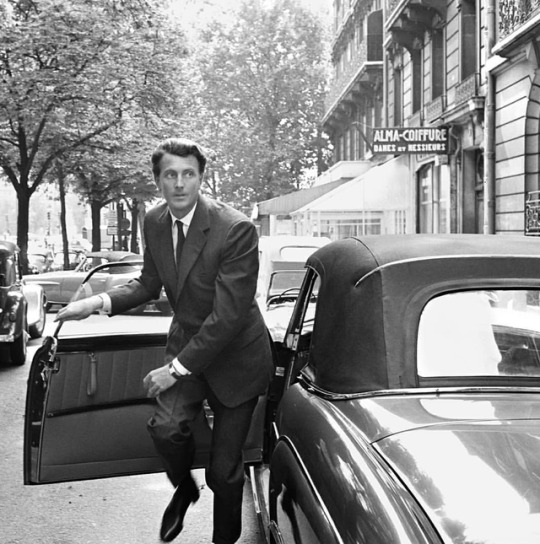
Hubert de Givenchy
#hubert de givenchy#french fashion designers#tony vaccaro#b&w photography#paris#france#1960s#men's style#men's fashion
190 notes
·
View notes
Text
UI/UX Design vs. Product Design: Understanding the Key Differences and Career Paths
In today’s digital landscape, the roles of UI/UX designers and product designers are increasingly essential, but often misunderstood. Although they share similarities and overlap, each role has unique responsibilities, skills, and workflows. Understanding these distinctions can help aspiring designers choose the right career path and provide valuable insights into the dynamic world of design.
Defining UI/UX Design and Product Design
UI/UX Design: UI (User Interface) design emphasizes the visual appearance and aesthetic appeal of a product. It involves creating visually appealing and intuitive interfaces that facilitate user interactions. UX (User Experience) design, on the other hand, emphasizes the overall experience users have with a product. It involves researching, testing, and optimizing the user’s journey to ensure it is smooth, efficient, and enjoyable.
Product Design: Product design encompasses a broader scope, involving the entire lifecycle of a product. Product designers are responsible for defining the product’s vision, functionality, and usability. They often collaborate with various teams, including UI/UX designers, engineers, and marketers, to bring a product from concept to market. This role requires a deep understanding of both user needs and business goals.
Key Responsibilities
UI/UX Designer Responsibilities: 1. User Research: Conducting interviews, surveys, and usability tests to understand user needs and preferences. 2. Wireframing and Prototyping: Creating wireframes and interactive prototypes to visualize the user interface and experience. 3. Visual Design: Designing the aesthetic aspects of the interface, including color schemes, typography, and layout. 4. Interaction Design: Defining how users interact with the product through animations, transitions, and microinteractions. 5. Usability Testing: Continuously testing and refining designs based on user feedback.
Product Designer Responsibilities: 1. Product Strategy: Defining the product vision, goals, and roadmap in alignment with business objectives. 2. Market Research: Analyzing market trends, competitor products, and user needs to identify opportunities. 3. Ideation and Concept Development: Brainstorming and developing product concepts and features. 4. Design and Prototyping: Creating detailed designs and prototypes, often in collaboration with UI/UX designers. 5. Cross-Functional Collaboration: Working with engineering, marketing, and sales teams to ensure the product’s success. 6. Product Testing and Iteration: Continuously testing and iterating on the product based on user feedback and performance metrics.
Skills and Tools
UI/UX Designer Skills: 1. Design Principles: Deep knowledge of color theory, typography, and layout. 2. User Research: Proficiency in conducting and analyzing user research. 3. Wireframing and Prototyping Tools: Expertise in tools like Sketch, Figma, Adobe XD, and InVision. 4. Interaction Design: Ability to create engaging and intuitive interactions. 5. Usability Testing: Skill in designing and conducting usability tests.
Product Designer Skills: 1. Strategic Thinking: Ability to align product design with business goals and market trends. 2. User-Centered Design: Strong focus on understanding and meeting user needs. 3. Cross-Functional Collaboration: Excellent communication and teamwork skills. 4. Prototyping and Design Tools: Proficiency in tools like Sketch, Figma, and InVision, as well as knowledge of basic coding principles. 5. Analytical Skills: Ability to analyze data and user feedback to inform design decisions.
Workflow and Process
UI/UX Design Workflow: 1. Research: Gathering insights through user interviews, surveys, and usability tests. 2. Wireframing: Creating wireframes to outline the structure and layout of the interface. 3. Prototyping: Developing interactive prototypes to test and refine the user experience. 4. Visual Design: Designing the final visual elements of the interface. 5. Usability Testing: Continuously testing and iterating on the design based on user feedback.
Product Design Workflow: 1. Ideation: Brainstorming and conceptualizing product ideas and features. 2. Research: Conducting market research and user research to validate ideas. 3. Design and Prototyping: Creating detailed designs and prototypes in collaboration with UI/UX designers. 4. Development: Working with engineering teams to build and test the product. 5. Launch and Iteration: Releasing the product and continuously refining it based on user feedback and performance metrics.
Overlapping Areas While UI/UX design and product design have distinct roles, there is significant overlap. Both roles require a strong focus on user-centered design, collaboration, and continuous iteration based on feedback. UI/UX designers frequently collaborate with product designers to ensure the user interface and experience are consistent with the overall product vision. Similarly, product designers rely on UI/UX designers to create intuitive and visually appealing interfaces that enhance the user experience.
Real-World Examples
UI/UX Design Example: A UI/UX designer at a tech startup might work on redesigning the company’s mobile app. They would conduct user interviews to understand pain points, create wireframes and prototypes, and test the new design with users. Their goal would be to improve the app’s usability and visual appeal, ensuring a seamless and enjoyable user experience.
Product Design Example: A product designer at a large e-commerce company might be responsible for developing a new feature for the company’s website. They would start by conducting market research and user interviews to validate the feature idea. Next, they would collaborate with UI/UX designers to create detailed designs and prototypes. After testing and iterating on the feature, they would work with engineering teams to build and launch it, continuously monitoring its performance and making improvements as needed.
Career Paths
UI/UX Design Career Path: - Entry-Level: Junior UI/UX Designer - Mid-Level: UI/UX Designer, Interaction Designer - Senior-Level: Senior UI/UX Designer, Lead UI/UX Designer - Leadership: UX Manager, Head of UX
Product Design Career Path: - Entry-Level: Junior Product Designer - Mid-Level: Product Designer, UX Designer - Senior-Level: Senior Product Designer, Lead Product Designer - Leadership: Product Design Manager, Head of Product Design
Conclusion Both UI/UX design and product design are essential for developing successful digital products. While they share common goals and overlap in many areas, they have distinct responsibilities, skills, and workflows. Understanding these differences can help aspiring designers choose the right career path and excel in their chosen field.
At Ajeenkya DY Patil University, we offer comprehensive programs tailored to these exciting fields. Our courses in UI/UX design and product design provide students with the knowledge, skills, and hands-on experience necessary to thrive in the industry. Whether you’re drawn to the visual and experiential aspects of UI/UX design or the strategic and holistic approach of product design, our programs are designed to equip you with the tools and expertise to succeed.
Join us at Ajeenkya DY Patil University and embark on a rewarding career journey in the dynamic world of design.
#adypu#ajeenkyadypatiluniversity#school of design#product design#b des programs#ui ux design#design education#fashion design#Transportation Design#Visual Communication
0 notes
Text
How to Excel in B Des Fashion and Interior Design Courses

The Bachelor of Design (B Des) in Fashion and Interior Design are two of the most sought-after courses for creative minds aiming to make a mark in the design industry. Excelling in these courses demands creativity, passion, and a strategic approach toward learning and practical application. Here’s how you can excel in B Des in Fashion Designing and B Des in Interior Designing, shaping a successful career in design.
Understand the Basics
The first step to excelling in any course is to build a strong foundation. Understanding the basics of design principles, history, materials, and techniques is crucial for fashion and interior design courses. Dive deep into the fundamental concepts and always stay curious to learn more. The basics will serve as your guide in every design challenge you face.
Practice Relentlessly
Design is a skill honed by practice. Regularly working on your drawing, sketching, and designing skills is essential. Whether it's fashion or interior design, the more you practice, the better you become. Experiment with different styles, materials, and techniques. This improves your skill set and helps you find your unique design voice.
Stay Updated with Trends
The design world is ever-evolving. Staying updated with the latest trends in fashion and interior design is important. However, it's also crucial to understand the history and evolution of design to predict future trends. Use online resources, magazines, and books to keep yourself informed. Attend workshops, exhibitions, and seminars whenever possible.
Leverage Technology
In this digital age, proficiency in design software and tools is as important as your creative skills. Learn to use software like Adobe Photoshop, Illustrator, AutoCAD, and SketchUp. These tools help bring your designs to life and are essential for presenting your ideas professionally.
Build a Portfolio
Your portfolio is a reflection of your skills and creativity. Start building your portfolio from the beginning of your course. Include a variety of work showcasing your skills, creativity, and understanding of design principles. A strong portfolio is crucial when applying for internships or jobs.
Seek Real-world Experience
Internships and part-time jobs provide invaluable real-world experience. They offer a glimpse into the industry's workings and help build a professional network. Try to secure internships in reputable design firms or with established designers. The practical experience gained will be instrumental in your growth and success.
Collaborate and Network
Building a network within the design community is vital. Collaborate with peers on projects, participate in design competitions, and attend industry events. Networking helps you share ideas, learn from others, and open up opportunities for future collaborations and job prospects.
Reflect and Iterate
Design is an iterative process. Always be open to feedback and willing to make changes to your designs. Reflect on your work critically and learn from both successes and failures. Continuous improvement is key to mastering the art of design.
Swarrnim University: Shaping Future Designers
Swarrnim University, situated in the heart of Gandhinagar, offers comprehensive B Des courses in Fashion Designing and Interior Designing. With a focus on practical learning, the university provides state-of-the-art facilities, experienced faculty, and a curriculum that aligns with the industry’s current demands.
The interior design course in Gandhinagar at Swarrnim University is designed to equip students with creative skills and practical knowledge. Students are encouraged to experiment, innovate, and develop designs that are aesthetically pleasing but also functional and sustainable.
Similarly, the B Des in Fashion Designing course at Swarrnim University focuses on developing the students' understanding of fashion trends, materials, and the fashion industry's business aspects. The course aims to nurture creative minds who can contribute to the fashion industry with innovative designs.
At Swarrnim University, students have numerous opportunities to engage in real-world projects, internships, and workshops with industry professionals. This hands-on approach ensures that students are well-prepared to embark on their design careers upon graduation.
Conclusion
Excelling a B Des in Fashion Designing and a B Des in Interior Designing requires a mix of creativity, hard work, and strategic learning. By understanding the basics, practicing relentlessly, staying updated with trends, leveraging technology, building a strong portfolio, seeking real-world experience, collaborating, and continuously improving, you can set the foundation for a successful career in the design industry. Swarrnim University, with its comprehensive courses and industry-aligned curriculum, serves as an ideal platform for aspiring designers to realize their potential and craft their future in the design world.
#B Des in fashion designing#B Des in interior designing#Interior design course in Gandhinagar#swarrnim university Gujarat#ssiu gandhiangar
0 notes
Text
Did the ancient Celts really paint themselves blue?
Part 2: Irish tattoos


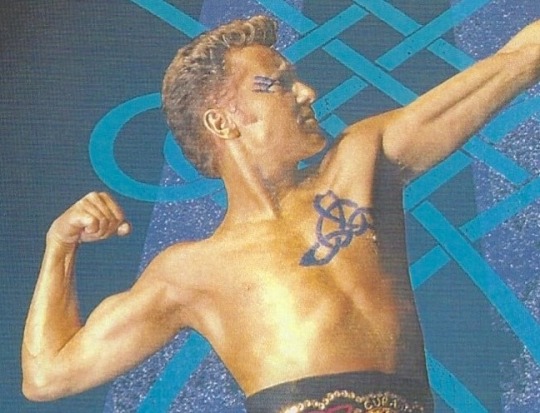
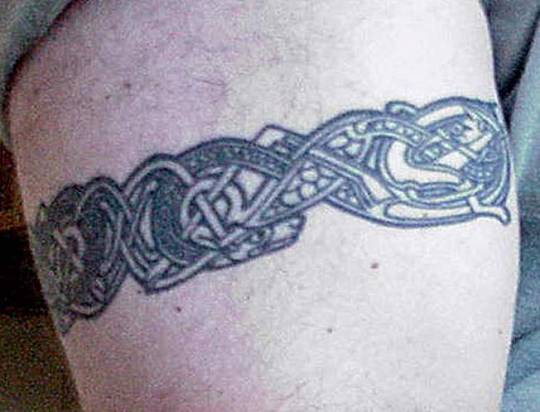
Clockwise from top left: Deirdre and Naoise from the Ulster Cycle by amylouioc, detail from The Marriage of Strongbow and Aoife by Daniel Maclise, a modern Celtic revival tattoo, Michael Flatley in a promotional image for the Irish step dance show 'Lord of the Dance'
This is my second post exploring the historical evidence for our modern belief that the ancient and medieval Insular Celts painted or tattooed themselves with blue pigment. In the first post, I discussed the fact that body paint seems to have been used by residents of Great Britain between approximately 50 BCE to 100 CE. In this post, I will examine the evidence for tattooing.
Once again, I am looking at sources pertaining to any ethnic group who lived in the British Isles, this time from the Roman Era to the early Middle Ages. The relevant text sources range from approximately 200 CE to 900 CE. I am including all British Isles cultures, because a) determining exactly which Insular culture various writers mean by terms like ‘Briton’, ‘Scot’, and ‘Pict’ is sometimes impossible and b) I don’t want to risk excluding any relevant evidence.
Continental Written Sources:
The earliest written source to mention tattoos in the British Isles is Herodian of Antioch’s History of the Roman Empire written circa 208 CE. In it, Herodian says of the Britons, "They tattoo their bodies with colored designs and drawings of all kinds of animals; for this reason they do not wear clothes, which would conceal the decorations on their bodies" (translation from MacQuarrie 1997). Herodian is probably reporting second-hand information given to him by soldiers who fought under Septimius Severus in Britain (MacQuarrie 1997) and shouldn't be considered a true primary source.
Also in the early 3rd century, Gaius Julius Solinus says in Collectanea Rerum Memorabilium 22.12, "regionem [Brittaniae] partim tenent barbari, quibus per artifices plagarum figuras iam inde a pueris variae animalium effigies incorporantur, inscriptisque visceribus hominis incremento pigmenti notae crescunt: nec quicquam mage patientiae loco nationes ferae ducunt, quam ut per memores cicatrices plurimum fuci artus bibant."
Translation: "The area [of Britain] is partly occupied by barbarians on whose bodies, from their childhood upwards, various forms of living creatures are represented by means of cunningly wrought marks: and when the flesh of the person has been deeply branded, then the marks of the pigment get larger as the man grows, and the barbaric nations regard it as the highest pitch of endurance to allow their limbs to drink in as much of the dye as possible through the scars which record this" (from MacQuarrie 1997).
This passage, like Herodian's, is clearly a description of tattooing, not body staining or painting. That said, I have no idea of tattoos actually work like this. I would think this would result in the adult having a faded, indistinct tattoo, but if anyone knows otherwise, please tell me.
The poet Claudian, writing in the early 5th c., is the first to specifically mention the Picts having tattoos (MacQuarrie 1997). In De Bello Gothico he says, "Venit & extremis legio praetenta Britannis,/ Quæ Scoto dat frena truci, ferroque notatas/ Perlegit exanimes Picto moriente figuras."
Translation: "The legion comes to make a trial of the most remote parts of Britain where it subdues the wild Scot and gazes on the iron-wrought figures on the face of the dying Pict" (from MacQuarrie 1997).
Last, and possibly least, of our Mediterranean sources is Isidore of Seville. In the early 7th c. he writes, "the Pictish race, their name derived from their body, which the efficient needle, with minute punctures, rubs in the juices squeezed from native plants so that it may bring these scars to its own fashion [. . .] The Scotti have their name from their own language by reason of [their] painted body, because they are marked by iron needles with dark coloring in the form of a marking of varying shapes." (translation from MacQuarrie 1997)
Isidore is the earliest writer to explicitly link the name 'Pict' to their 'painted' (Latin: pictus) i.e. tattooed bodies. Isidore probably borrowed information for his description from earlier writers like Claudian (MacQuarrie 1997).
In the 8th century, we have a source that definitely isn't Romans recycling old hearsay. In 786, a pair of papal legates visited the Anglo-Saxon kingdoms of Mercia and Northumbria (Story 1995). In their report to Pope Hadrian, the legates condemn pagans who have "superimposed most hideous cicatrices" (i.e gotten tattoos), likening the pagan practice to coloring oneself "with dirty spots". The location of the visit indicates that these are Anglo-Saxon tattoos rather than Celtic, but some scholars have suggested that the Anglo-Saxons might have adopted the practice from the Brittonic Celts (MacQuarrie 1997).
A gloss in the margin of the late 9th c. German manuscript Fulda Aa 2 defines Stingmata [sic] as "put pictures on the bodies as the Irish (Scotti) do." (translation from MacQuarrie 1997).
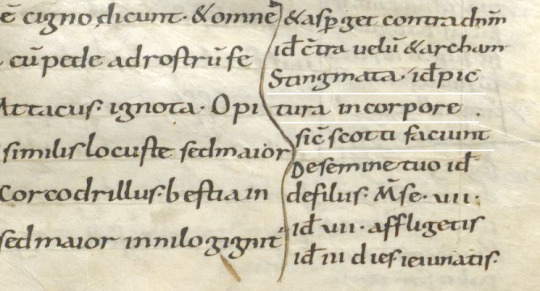
Fulda Aa 2 folio 43r The gloss is on the left underlined in white.
Irish Written Sources:
Irish texts that mention tattoos date to approximately 700-900 CE, although some of them have glosses that may be slightly later, and some of them cannot be precisely dated.
The first text source is a poem known in English as "The Caldron of Poesy," written in the early 8th c. (Breatnach 1981). The poem is purportedly the work of Amairgen, ollamh of the legendary Milesian kings. In the first stanza of the poem, he introduces himself saying, "I being white-kneed, blue-shanked, grey-bearded Amairgen." (translation from Breatnach 1981)
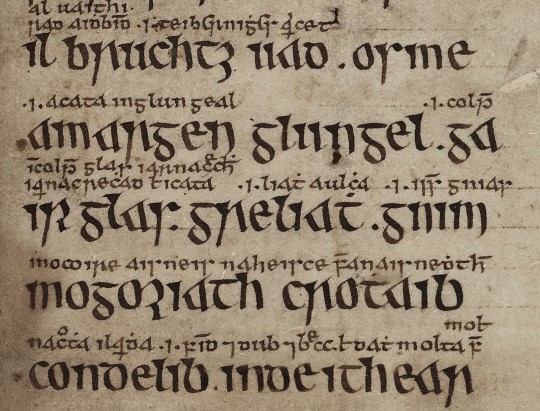
The text of the poem with interline glosses from Trinity College Dublin MS 1337/1
The word garrglas (blue-shanked) has a Middle Irish (c. 900-1200) gloss added by a later scribe, defining garrglas as: "a tattooed shank, or who has the blue tattooed shank" (Breatnach 1981).
Although Amairgen was a mythical figure, the position ollamh was not. An ollamh was the highest rank of poet in medieval Ireland, considered worthy of the same honor-price as a king (Carey 1997, Breatnach 1981). The fact that a man of such esteemed status introduces himself with the descriptor 'blue-shanked' suggests that tattoos were a respectable thing to have in early medieval Ireland.
The leg tattoos are also mentioned c. 900 CE in Cormac’s Glossary. It defines feirenn as "a thong which is about the calf of a man whence ‘a tattooed thong is tattooed about [the] calf’" (translation from MacQuarrie 1997)
The Irish legal text Uraicecht Becc, dated to the 9th or early 10th c., includes the word creccoire on a list of low-status occupations (Szacillo 2012, MacNeill 1924). A gloss defines it as: crechad glass ar na roscaib, a phrase which Szacillo interprets as meaning "making grey-blue sore (tattooing) on the eyes" (2012). This sounds rather strange, but another early Irish text clarifies it.
The Vita sancti Colmani abbatis de Land Elo written around the 8th-9th centuries (Szacillo 2012) contains the following episode:
On another time, St Colmán, looking upon his brother, who was the son of Beugne, saw that the lids of his eyes had been secretly painted with the hyacinth colour, as it was in the custom; and it was a great offence at St Colmán’s. He said to his brother: ‘May your eyes not see the light in your life (any more). And from that hour he was blind, seeing nothing until (his) death. (translation from Szacillo 2012).
The original Latin phrase describing what so offended St Colmán "palpebre oculorum illius latenter iacinto colore" does not contain the verb paint (pingo). It just says his eyelids were hyacinth (blue) colored. This passage together with the gloss from the Uraicecht Becc implies that there was a custom of tattooing people's eyelids blue in early medieval Ireland. A creccoire* was therefore a professional eyelid tattooer or a tattoo artist.
A possible third reference to tattooing the area around the eye is found in a list of Old Irish kennings. The kenning for the letter 'B' translates as 'Beauty of the eyebrow.' This kenning is glossed with the word crecad/creccad (McManus 1988). Crecad could be translated as cauterizing, branding, or tattooing (eDIL). McManus suggests "adornment (by tattooing) of the eyebrow" as a plausible interpretation of how crecad relates to the beauty of the eyebrow (1988). The precise date of this text is not known (McManus 1988), but Old Irish was used c. 600-900 CE, meaning this text is of a similar date to the other Irish references to tattoos.
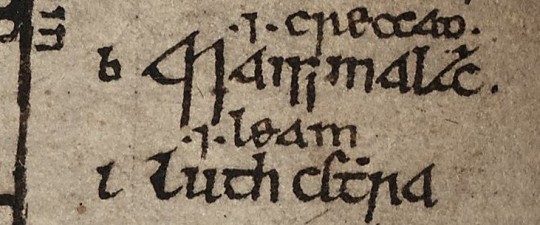
Kenning of the letter 'b' with gloss from TCD MS 1337/1
There is a sharp contrast between the association of tattoos with a venerated figure in 'The Caldron of Poesy', and their association with low-status work and divine punishment in the Uraicecht Becc and the Vita. This indicates that there was a shift in the cultural attitude towards tattoos in Ireland during the 7th-9th centuries. The fact that a Christian saint considered getting tattoos a big enough offense to punish his own brother with blindness suggests that tattooing might have been a pagan practice which gradually got pushed out by the Catholic Church. This timeline is consistent with the 786 CE report of the papal legates condemning the pagan practice of tattooing in Great Britain (MacQuarrie 1997).
There are some mentions of tattooing in Lebor Gabála Érenn, but the information largely appears to be borrowed from Isidore of Seville (MacQuarrie 1997). The fact that the writers of LGE just regurgitated Isidore's meager descriptions of Pictish and Scottish (ie Irish) tattooing without adding any details, such as the designs used or which parts of the body were tattooed, makes me think that Insular tattooing practices had passed out of living memory by the time the book was written in the 11th century.
*There is some etymological controversy over this term. Some have suggested that the Old Irish word for eyelid-tattooer should actually be crechaire. more info Even if this hypothesis is correct, and the scribe who wrote the gloss on creccoire mistook it for crechaire, this doesn't contradict my argument. The scribe clearly believed that eyelid-tattooer belonged on a list of low-status occupations.
Discussion:
Like Julius Cesar in the last post, Herodian of Antioch c. 208 CE makes some dubious claims of Celtic barbarism, stating that the Britons were: "Strangers to clothing, the Britons wear ornaments of iron at their waists and throats; considering iron a symbol of wealth, they value this metal as other barbarians value gold" (translation from MacQuarrie 1997). If the Britons wore nothing but iron jewelry, then why did they have brass torcs and 5,000 objects that look like they're meant to attach to fabric, Herodian?
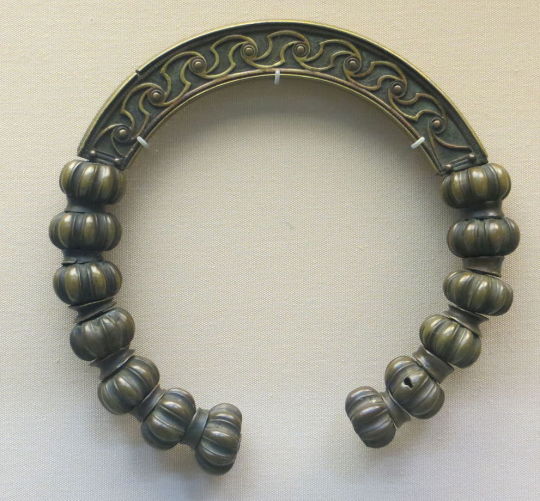
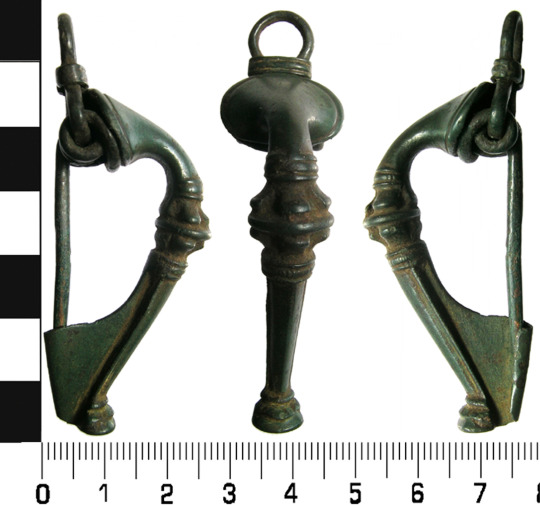
Brass torc from Lochar Moss, Scotland c. 50-200 CE. Romano-British trumpet brooch from Cumbria c. 75-175 CE. image from the Portable Antiquities Scheme.
Trumpet brooches are a Roman Era artifact invented in Britain, that were probably pinned to people's clothing. more info
Although Herodian and Solinus both make dubious claims, there are enough differences between them to indicate that they had 2 separate sources of information, and one was not just parroting the other. This combined with the fact that we have more-reliable sources from later centuries confirming the existence of tattoos in the British Isles makes it probable that there was at least a grain of truth to their claims of tattooing.
There is a common belief that the name Pict originated from the Latin pictus (painted), because the Picts had 'painted' or tattooed bodies. The Romans first used the name Pict to refer to inhabitants of Britain in 297 CE (Ware 2021), but the first mention of Pictish tattoos came in 402 CE (Carr 2005), and the first explicit statement that the name Pict was derived from the Picts' tattooed bodies came from Isidore of Seville c. 600 CE (MacQuarrie 1997). Unless someone can find an earlier source for this alleged etymology than Isidore, I am extremely skeptical of it.
Summary of the written evidence:
Some time between c. 79 CE (Pliny the Elder) and c. 208 CE (Herodian of Antioch) the practice of body art in Great Britain changed from staining or painting the skin to tattooing. Third century Celtic Briton tattoo designs depicted animals. Pictish tattoos are first mentioned in the 5th century.
The earliest mention of Irish tattoos comes from Isidore of Seville in the early 6th c., but since it seems to have been a pre-Christian practice, it likely started earlier. Irish tattoos of the 8-9th centuries were placed on the area around the eye and on the legs. They were a bluish color. The 8th c. Anglo-Saxons also had tattoos.
Tattooing in Ireland probably ended by the early 10th c., possibly because of Christian condemnation. Exactly when tattooing ended in Great Britain is unclear, but in the 12th c., William of Malmesbury describes it as a thing of the past (MacQuarrie 1997). None of these sources give much detail as to what the tattoos looked like.
The Archaeology of Insular Ink:
In spite of the fact that tattooing was a longer-lasting, more wide-spread practice in the British Isles than body painting, there is less archaeological evidence for it. This may be because the common tools used for tattooing, needles or blades for puncturing the skin, pigments to make the ink, and dishes to hold the ink, all had other common uses in the Middle Ages that could make an archaeologist overlook their use in tattooing. The same needle that was used to sew a tunic could also have been used to tattoo a leg (Carr 2005). A group of small, toothed bronze plates from a Romano-British site at Chalton, Hampshire might have been tattoo chisels (Carr 2005) or they might have been used to make stitching holes in leather (Cunliffe 1977).
Although the pigment used to make tattoos may be difficult to identify at archaeological sites, other lines of evidence might give us an idea of what it was. Although the written sources tell us that Irish tattoos were blue, the popular modern belief that woad was the source of the tattoo pigment is, in my opinion, extremely unlikely for a couple of reasons:
1) Blue pigment from woad doesn't seem to work as tattoo ink. The modern tattoo artists who have tried to use it have found that it burns out of the person's skin, leaving a scar with no trace of blue in it (Lambert 2004).
2) None of the historical sources actually mention tattooing with woad. Julius Cesar and Pliny the Elder mention something that might have been woad, but they were talking about body paint, not tattoos. (see previous post) Isidore of Seville claimed that the Picts were tattooing themselves with "juices squeezed from native plants", but even assuming that Isidore is a reliable source, you can't get blue from woad by just squeezing the juice out of it. In order to get blue out of woad, you have to first steep the leaves, then discard the leaves and add a base like ammonia to the vat (Carr 2005). The resulting dye vat is not something any knowledgeable person would describe as plant juice, so either Isidore had no idea what he was talking about, or he is talking about something other than blue pigment from woad.
In my opinion, the most likely pigment for early Irish and British tattoos is charcoal. Early tattoos found on mummies from Europe and Siberia all contain charcoal and no other colored pigment. These tattoos range in date from c. 3300 BCE (Ötzi the Iceman) to c. 300 CE (Oglakhty grave 4) (Samadelli et al 2015, Pankova 2013).
Despite the fact that charcoal is black, it tends to look blueish when used in tattoos (Pankova 2013). Even modern black ink tattoos that use carbon black pigment (which is effectively a purer form of charcoal) tend to look increasingly blue as they age.
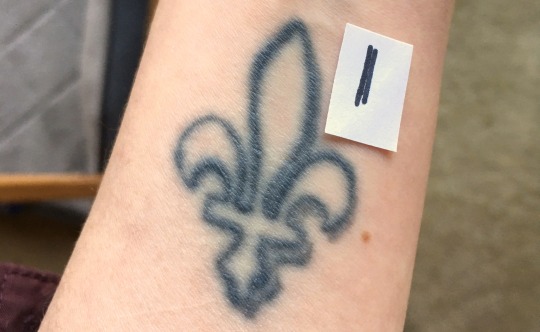
A 17-year-old tattoo in carbon black ink photographed with a swatch of black Sharpie on white printer paper.
The fact that charcoal-based tattoo inks continue to be used today, more than 5,000 years after the first charcoal tattoo was given, shows that charcoal is an effective, relatively safe tattoo pigment, unlike woad. Additionally, charcoal can be easily produced with wood fires, meaning it would have been a readily available material for tattoo artists in the early medieval British Isles. We would need more direct evidence, like a tattooed body from the British Isles, to confirm its use though.
As of June 2024, there have been at least 279 bog bodies* found in the British Isles (Ó Floinn 1995, Turner 1995, Cowie, Picken, Wallace 2011, Giles 2020, BBC 2024), a handful of which have made it into modern museum collections. Unfortunately, tattoos have not been found on any of them. (We don't have a full scientific analysis for the 2023 Bellaghy find yet though.)
*This number includes some finds from fens. It does not include the Cladh Hallan composite mummies.
Tattoos in period art?
It has been suggested that the man fight a beast on Book of Kells f. 130r may be naked and covered in tattoos (MacQuarrie 1997). However, Dress in Ireland author Mairead Dunlevy interprets this illustration as a man wearing a jacket and trews (Dunlevy 1989). Looking at some of the other figures in the Book of Kells, I agree with Dunlevy. F. 97v shows the same long, fitted sleeves and round neckline. F. 292r has long, fitted leg coverings, presumably trews, and also long sleeves. The interlace and dot motifs on f. 130r's legs may be embroidery. Embroidered garments were a status symbol in early medieval Ireland (Dunlevy 1989).

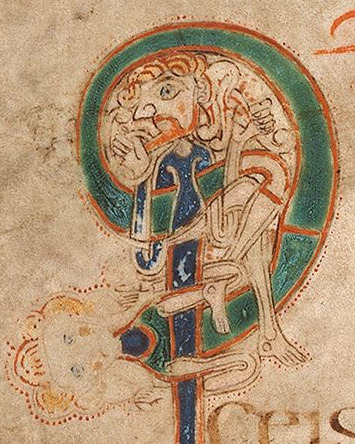

Left to right: Book of Kells folios 130r, 97v, 292r
A couple of sculptures in County Fermanagh might sport depictions of Irish tattoos. The first, known as the Bishop stone, is in the Killadeas cemetery. It features a carved head with 2 marks on the left side of the face, a double line beside the mouth and a single line below the eye. These lines may represent tattoos.
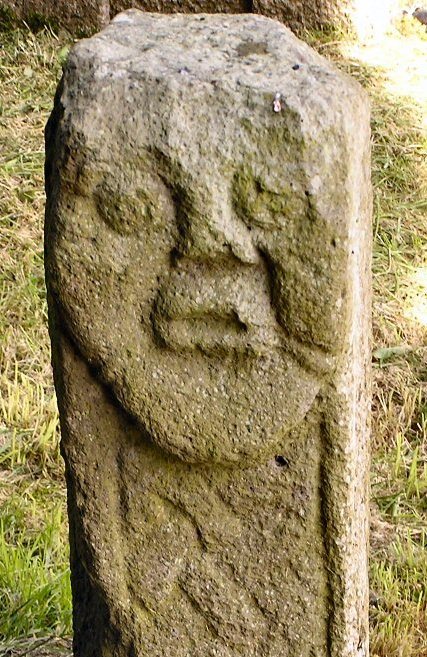
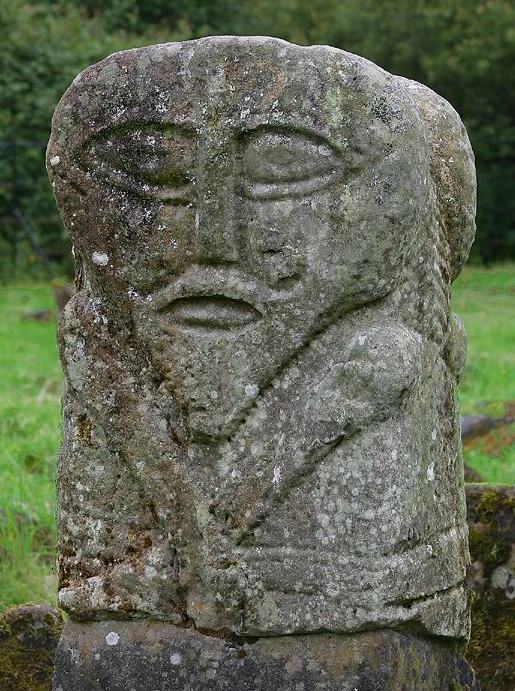
The second sculpture is the Janus figure on Boa Island. (So named because it has 2 faces; it's not Roman.) It has marks under the right eye and extending from the corner of the left eye that may be tattoos.
I cannot find a definitive date for the Bishop stone head, but it bears a strong resemblance to the nearby White Island church figures. The White Island figures are stylistically dated to the 9th-10th centuries and may come from a church that was destroyed by Vikings in 837 CE (Halpin and Newman 2006, Lowry-Corry 1959). The Janus figure is believed to be Iron Age or early medieval (Halpin and Newman 2006).
Conclusions:
Despite the fact that tattooing as a custom in the British Isles lasted for more than 500 years and was practiced by at least 3 different cultures, written sources remain our only solid evidence for it. With only a dozen sources, some of which probably copied each other, to cover this time span, there are huge gaps in our knowledge. The 4th century Picts may not have had the same tattoo designs, placements or reasons for getting tattooed as the 8th c. Irish or Anglo-Saxons. These sources only give us fragments of information on who got tattooed, where the tattoos were placed, what they looked like, how the tattoos were done, and why people got tattooed. Further complicating our limited information is the fact that most of the text sources come from foreigners and/or people who were prejudiced against tattooing, which calls their accuracy into question.
'The Cauldron of Posey' is one source that provides some detail while not showing prejudice against tattoos. The author of the poem was probably Christian, but the poem appears to have been written at a time when Pagan practices were still tolerated in Ireland. I have a complete translation of the poem along with a longer discussion of religious elements here.
Leave me a tip?
Bibliography:
BBC (2024). Bellaghy bog body: Human remains are 2,000 years old https://www.bbc.com/news/uk-northern-ireland-68092307
Breatnach, L. (1981). The Cauldron of Poesy. Ériu, 32(1981), 45-93. https://www.jstor.org/stable/30007454
Carey, J. (1997). The Three Things Required of a Poet. Ériu, 48(1997), 41-58. https://www.jstor.org/stable/30007956
Carr, Gillian. (2005). Woad, Tattooing and Identity in Later Iron Age and Early Roman Britain. Oxford Journal of Archaeology 24(3), 273–292. https://doi.org/10.1111/j.1468-0092.2005.00236.x
Cowie, T., Pickin, J. and Wallace, T. (2011). Bog bodies from Scotland: old finds, new records. Journal of Wetland Archaeology 10(1): 1–45.
Cunliffe, B. (1977) The Romano-British Village at Chalton, Hants. Proceedings of the Hampshire Field Club and Archaeological Society, 33(1977), 45-67.
Dunlevy, Mairead (1989). Dress in Ireland. B. T. Batsford LTD, London.
eDIL s.v. crechad https://dil.ie/12794
Giles, Melanie. (2020). Bog Bodies Face to face with the past. Manchester University Press, Manchester. https://library.oapen.org/viewer/web/viewer.html?file=/bitstream/handle/20.500.12657/46717/9781526150196_fullhl.pdf?sequence=1&isAllowed=y
Halpin, A., Newman, C. (2006). Ireland: An Oxford Archaeological Guide to Sites from Earliest Times to AD 1600. Oxford University Press, Oxford. https://archive.org/details/irelandoxfordarc0000halp/page/n3/mode/2up
Hoecherl, M. (2016). Controlling Colours: Function and Meaning of Colour in the British Iron Age. Archaeopress Publishing LTD, Oxford. https://www.google.com/books/edition/Controlling_Colours/WRteEAAAQBAJ?hl=en&gbpv=0
Lambert, S. K. (2004). The Problem of the Woad. Dunsgathan.net. https://dunsgathan.net/essays/woad.htm
Lowry-Corry, D. (1959). A Newly Discovered Statue at the Church on White Island, County Fermanagh. Ulster Journal of Archaeology, 22(1959), 59-66. https://www.jstor.org/stable/20567530
MacQuarrie, Charles. (1997). Insular Celtic tattooing: History, myth and metaphor. Etudes Celtiques, 33, 159-189. https://doi.org/10.3406/ecelt.1997.2117
McManus, D. (1988). Irish Letter-Names and Their Kennings. Ériu, 39(1988), 127-168. https://www.jstor.org/stable/30024135
Ó Floinn, R. (1995). Recent research into Irish bog bodies. In R. C. Turner and R. G. Scaife (eds) Bog Bodies: New Discoveries and New Perspectives (p. 137–45). British Museum Press, London. ISBN: 9780714123059
Pankova, S. (2013). One More Culture with Ancient Tattoo Tradition in Southern Siberia: Tattoos on a Mummy from the Oglakhty Burial Ground, 3rd-4th century AD. Zurich Studies in Archaeology, 9(2013), 75-86.
Samadelli, M., Melisc, M., Miccolic, M., Vigld, E.E., Zinka, A.R. (2015). Complete mapping of the tattoos of the 5300-year-old Tyrolean Iceman. Journal of Cultural Heritage, 16(2015), 753–758.
Story, Joanna (1995). Charlemagne and Northumbria : the in
fluence of Francia on Northumbrian politics in the later eighth and early ninth centuries. [Doctoral Thesis]. Durham University. http://etheses.dur.ac.uk/1460/
Szacillo, J. (2012). Irish hagiography and its dating: a study of the O'Donohue group of Irish saints' lives. [Doctoral Thesis]. Queen's University Belfast.
Turner, R.C. (1995). Resent Research into British Bog Bodies. In R. C. Turner and R. G. Scaife (eds) Bog Bodies: New Discoveries and New Perspectives (p. 221–34). British Museum Press, London. ISBN: 9780714123059
Ware, C. (2021). A Literary Commentary on Panegyrici Latini VI(7) An Oration Delivered Before the Emperor Constantine in Trier, ca. AD 310. Cambridge University Press, Cambridge. https://www.google.com/books/edition/A_Literary_Commentary_on_Panegyrici_Lati/oEwMEAAAQBAJ?hl=en&gbpv=0
#early medieval#roman era#pict#tattoos#ancient celts#apologies to people who wanted a shorter post#archaeology#art#anecdotes and observations#statutes and laws#irish history#gaelic ireland#medieval ireland#anglo saxon#insular celts#romano british
125 notes
·
View notes
Text
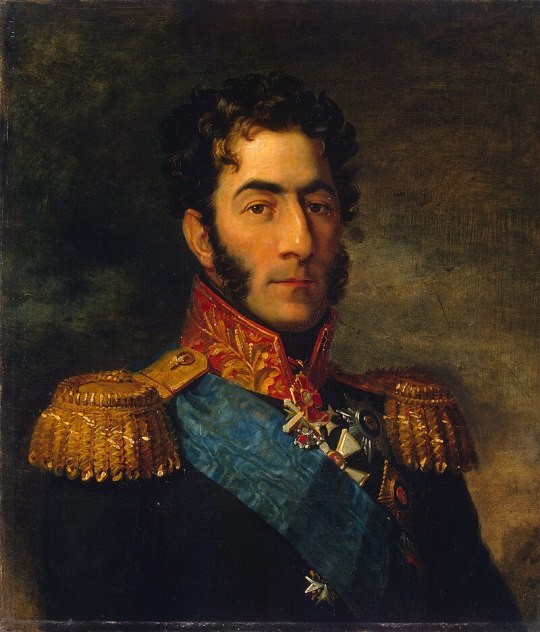
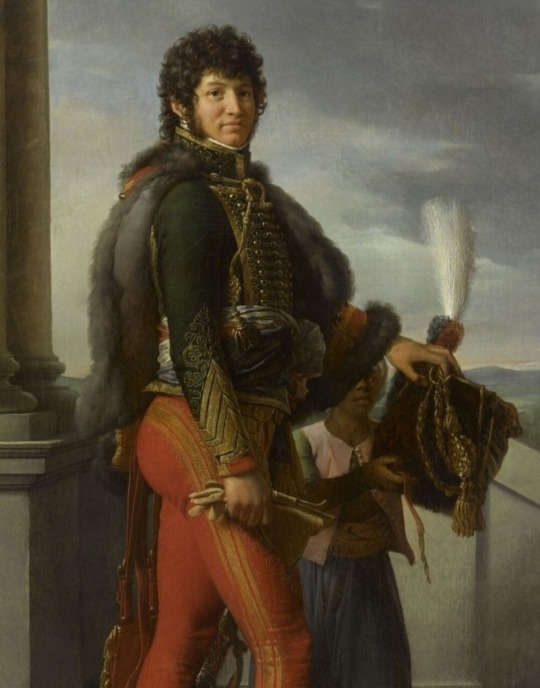
Pyotr Bagration
a. “From what I’ve read, he was a shy sweetheart outside of war, and an absolutely badass during battle. Like- it was partially that shyness that got him caught up in his less than favorable marriage. Also, have you seen his portrait by George Dawes?! It makes me swoon at the sight of it.”
b. “The best, the sexiest and certainly the greatest NOSE in the Russian army and perhaps all armies of that period. Noseys of Napoleonic era, beware! Believed to be a target of Grand Duchess Catherine Pavlovna's affections, a soldier's soldier celebrated for his courage and spirit, respected even by Napoleon and widely beloved… with the noted exceptions of his own wife and one Barclay de Tolly.”
c. “His sideburns and his nose”
Joachim Murat:
a. “Serving cunt and cake (seriously, look up his Hussar portrait)”
b. “see: any portrait of him. dat ass in dat hussar's uniform.”
c. “He is the First Horseman of France, he is a Grand Admiral who can’t fuckin sail a ship. He allegedly had “For France and For The Ladies” on his sword. He was often called “Beau Sabreur” which some will tell you means Dashing Swordsman. He looked after his appearance, getting a servant to help curl those locks around his fingers and designing so many uniforms - he had the fashion game! And when he died he asked his firing squad to aim at the heart and spare the face, because he knew he was a sexyman to the end.”
95 notes
·
View notes
Note
Hello! Sorry if you have answered this before, I have a question for Perrault's Sleeping Beauty. When the prince awakes the princess, he takes note of her clothes that look like his grandmother's, and specifically of the 'collet monté' of her dress. Would that be one of those 16th century frilly collars or another period?
It is technically speaking one of those "16th century frilly collars" and yet not really...
The type of collet monté that is talked about by Perrault is one that was not worn by women anymore in the 1690s (though still worn by men, under the name "rabat"), to the point it was used as an expression to designate elderly women.
According to the footnotes of my study-edition of the tales, the collet monté started being worn by women at the end of the rule of Henry IV (though a fashion website I consulted rather speaks of the end of the rule of Henry III). An article on the blog of an association dedicated to Perrault's work precises the fashion started with Catherine de Médicis and died with her - they were called "collet" (of the name of the traps hunters used to strangle rabbits) because it covered the whole neck, and "monté" because of how it was made - a light material stiffened, rigidified, mounted on a small tructure of cardboard or iron wire. In fact this is why collet monté became in the French language a common expression to designate A) being strict (due to how wearing it made you look hard, stern, with you standing upright and not moving much) and B) being prude (because it was a type of collar actually fragile, and unfit for... let's say too much physical activity).
Here are some "collet monté" equivalents (though the first two are more of a fraise-collet monté ; the third one however is truly a collet monté):



The collet monté can be considered a subtype or an evolution of the "fraise" because it has its roots within the "first stage" of the fraise's life, in the 1560-1570s (it was the fraise "collerette"). Not to be confused with the "collerette" en éventail, which revealed the throat entirely ; and later the fraise became the "fraise a plateau" we most commonly know about. (It is all a bit confusing, especially since the various trends fed into each other and everything was a bit mixed up... it doesn't help that I am not an expert on historical fashion AT ALL)



And if you are wondering about the "rabat", which is the state of the collet monté now unisex at the time Perrault wrote, it sort of looked like how the male collet monté used to look sometimes:


#i think it feels how I am NOT at all on a comfortable ground here#i need to do more research on the exact fashions of the time#but yes roughly speaking this is sort of the idea for Sleeping Beauty's dress#covered neck and stiff high collar tightening around her throat
20 notes
·
View notes
Text
More p3r livebloggin/shitpost thoughts. Sorry for the crunchy pictures, literally I'm just too fried to import pics from my PS4.


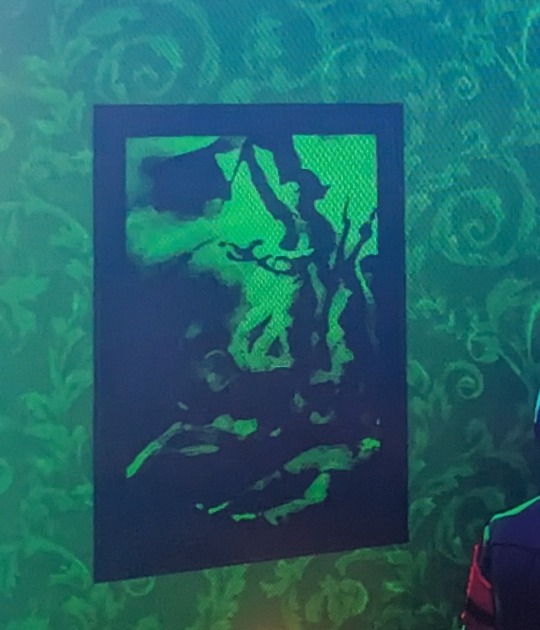
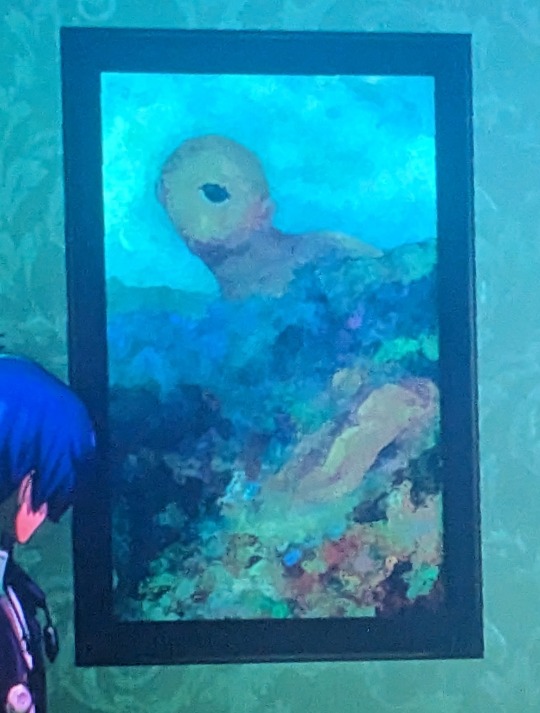
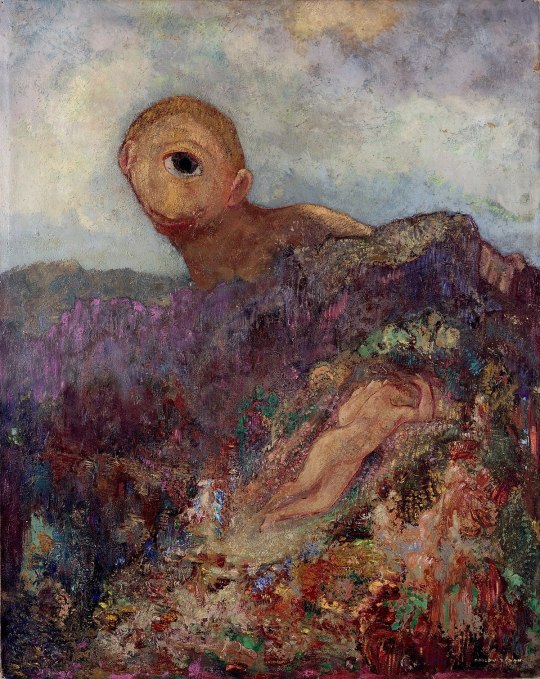
Because I'm the way that I am, I noticed the paintings hung in the Hierophant/Lovers boss shadow building are real paintings. One on the left is a crop of Liberty Leading the People by Eugene Delacroix, and on the right is Le Cyclops by Odilon Redon. IDK why they picked these paintings because. Why would a painting of the French Revolution be in this kind of hotel but I have some theories?
The hotel they're in is pointed out to have a French title and modeled after French design, for some reason. Les Champs de Fleurs is pointed out in the game meaning a field of flowers. Now -
Liberty Leading the People is a painting about the July revolution that overthrew the French monarchy. The boss event is in July but there's more -
Le Cyclops is about the play(s) about Polyphemus (the cyclops from the Odyssey that Odysseus blinds and tricks) and his love of the sea nymph Galatea, and the drama that ensues. There's many versions of the play but in classic fashion most of them don't end well, with Galatea rejecting him in favor of someone else, and Polyphemus killing them both. This painting in particular is basically Polyphemus creeping on Galatea as she sleeps on a hill of flowers.
I THINK these paintings are meant to represent the reverse hierophant and lovers. Overthrowing of the corrupt hierarchy, and rejection of choice. Also French.
There's one more painting but I have NO IDEA what painting it is
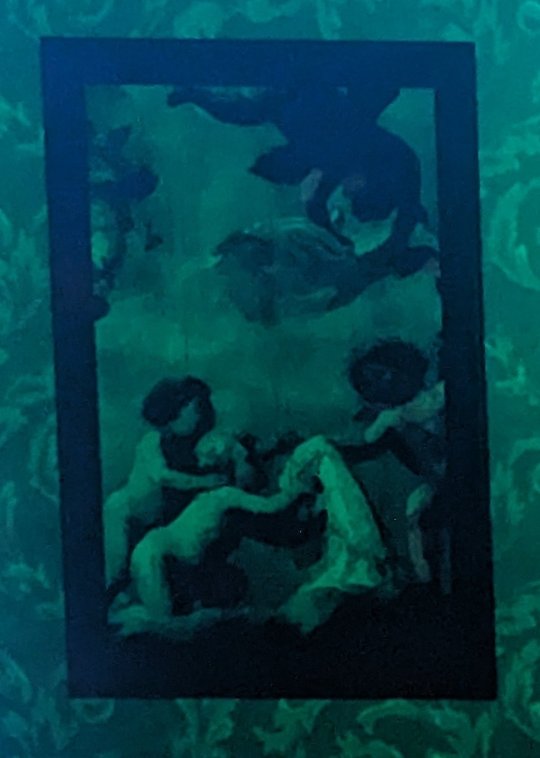
So many paintings have winged babies in them I can't go through them all 😭
Oh yeah linguistics bonus - the boss event takes place on 7/7, aka Tanabata. Some might know it as Japanese Valentine's day. Story goes Orihime and Hikoboshi, lovers separated by duty and the milky way, can meet during this festival as a flock of magpies make them a bridge over the milky way. Milky way, in Japanese is Amanogawa 天の川, literally "river of heaven". An older version is also sometimes used, ginka 銀河, derived from Chinese meaning "silver river". And here is where we get the name of Shirakawa Blvd. 白川...... White River Blvd.
I THINK that's why they named the hotel Champs de Fleurs. The classic Greek mythology of heaven is Elysium, basically a field of flowers in the sky. Kinda as the companion to the river in the sky. Not to mention it's a reference to the famous French street Champs Élysées, literally "Elysian Fields"
Imagine me standing in front of a conspiracy wall covered with red string. That's me all the time with p3
Ok back to shitposting

This is the most emotion I've seen the Mc make all game so far 😂 7 meals back to back will do that to ya. Name I picked was Dank Hour, so I guess it kinda fits. Munchies will do that

Those are her hooves!!

OH MY GOD. HOLY SHIT HANG ON

These puppets are massive
Gameplay thoughts -
- I miss the fatigue mechanic ok. Now there's NOTHING stopping me from spending five hours in Tartarus getting massively over leveled. Also miss it thematically and an excuse to go drink Edogawa's potions for courage boosts
- RIP shuffle time. The new one is good with the variety of cards but man make them fly around again that was fun
- Tartarus looks good. I was skeptical of how they're gonna make a randomly generated dungeon look good on current consoles but. It looks really good and plays well. And I love the added bonus bosses.
- I do miss being able to actually stealth around with different weapons and hunting rare shadows with a bow though. The unstable formations in p3p around half and new moons were also something I wish they incorporated, but maybe it'll come up later? Because the new Tartarus environment would be perfect for some stealth mechanics.
- I don't know if this is because I'm p3 Georg and an outlier that should not be counted but I'm playing on merciless and it's SO EASY???? I'm almost to August and I've ONLY died three times. I'm playing with a 3 people party as a debuff because it's too easy otherwise.
- ailments kinda work different than they used to and I still haven't figured out... What they really do yet. Distress used to guarantee criticals, now I'm not sure what it does???
- the theurgies are broken as hell wtf. This is too much power. I was really hoping they'd bring P2/dds style fusion spells back
General thoughts:
- they still haven't invented weather yet lmao rain was invented in 2011 I see
- Pleasantly surprised by the added cutscenes and hangout events in the dorm. They're actually pretty thoughtful and reflects on the character growth throughout the game instead of just ill humored filler (cough p4 cough). They really nailed it this time.
- Aigis trying to talk to plants and bugs and the meaning of lifeeeee 😭
- the club is simultaneous hilarious and terrifying in the way that they didn't animate the dancers. I get why, but it's so funny. It's just a room of statues with blank faces. At least there's more than five people there
- there's two poster of the Foo Fighters in the station outskirts. Why them specifically? Also if the movies at the theatre have hidden meanings I WILL find them.
- Mitsuru just stands like she's posing for the camera all the time and her idle AND angry animation being a hair flip is so funny. Hello. Flips hair. Come to the command room after dinner we have new mission. Flips hair. I'm going to execute Mr Ekoda for his despicable inaction. Flips hair
- Idk where else to put this but that scene on the roof with the watermelon hits different when you know a watermelon that size in Japan is, depending on the season and economy, at least $50. Junpei really splurged there to cheer up Ken 🥺. That entire scene was great. Why DON'T we watch Akihiko punch the melon open, what an inspired suggestion
- speaking of fruit, if you look at the care package Akihiko got from his parents there are mangoes in there. Mangoes that size and color are like $30 each.
- the dorm. Could be modeled better. Idk if it's the lighting or the textures but... It looks unfinished.
- they kept the little overworld icon that travels between locations to not go over the bridge even though it'd be a shorter route. Nice. There is an instance where it does use the bridge, when you first go to the police station and Junpei is following you around. Also very nice touch. Whichever dev is responsible for this detail I see and appreciate your work 🫡
- was not expecting even the NPCs to be fully voice acted. They're all so charming!
- at the beginning of the game it tells you to put your things away in the closet. Highlighted. But we can't open or interact with the closet in any way??? Why was closet highlighted??? Did the game do that just to call us gay??
- and also where's my silly outfit???? Everyone has gotten butler and maid outfits except the mc. Where's my goofy outfit I want one too.... Where's the clown outfit from the dancing game.... Where's the maid outfit.... Once my pc arrives I'll absolutely be installing the emo mod. Let my besties reveal their true 2009 forms
37 notes
·
View notes
Text
Which are the best BSc colleges in Haryana?
Several top colleges in Haryana offer quality B.Sc programs, including Kurukshetra University, Maharshi Dayanand University, and Chaudhary Devi Lal University. These institutions provide various science specializations with experienced faculty and research opportunities.
For students who are looking for an innovative education approach, Rishihood University offers a B.Sc program focused on creating impact-driven leaders. Their curriculum combines foundational science knowledge with hands-on training and interdisciplinary learning. Rishihood University emphasizes practical skills and personal growth. It stands out as a strong option for students who want an impactful career in science.
You can contact us by
Phone: +91 7669916629
Email: at [email protected]
Website: https://rishihood.edu.in/contact/
Visit us: at NH-44 (GT Road), Near Bahalgarh Chowk, Delhi NCR, Sonipat, Haryana – 131021
#bba finance#bba job opportunities#bba vs bcom#bachelor of design#b design#b des course#b design course#bachelor of fashion design
0 notes
Text
Step into Design Excellence at Woxsen University: A Launchpad for Creative Professions

Woxsen University stands as a beacon of design education in India, offering cutting-edge programs tailored to nurture creativity, innovation, and industry-relevant skills. Among its prestigious offerings are the B Des in Interior Designing and BDes Fashion Design programs, which are designed to meet the ever-evolving demands of the design industry. As one of the Top Design Colleges in India, Woxsen University provides an environment that fosters creative exploration and technical expertise, equipping students with the tools they need for successful design careers.
Why Choose Woxsen University for Design?
Woxsen University is renowned for its commitment to providing world-class education across various design disciplines. The university's design school boasts:
State-of-the-art Infrastructure: Modern facilities, including fully equipped design studios, digital labs, and innovative spaces for hands-on learning.
Experienced Faculty: A team of industry experts and seasoned educators guide students through both the creative process and practical applications.
Industry Connections: Strong collaborations with top design firms and industry professionals provide students with networking opportunities, internships, and real-world experience.
Innovative Curriculum: A curriculum that combines design theory, practical projects, and the latest technological tools in the design field.
B Des in Interior Designing: Crafting Spaces with Style and Functionality
The B Des in Interior Designing program at Woxsen University is a comprehensive course designed to teach students the art and science of designing aesthetically pleasing and functional interiors. This program blends creativity with technical know-how, ensuring that students are equipped to meet the demands of both residential and commercial interior design.
Key Highlights of the Program:
Design Concepts: Students learn to master color theory, spatial arrangements, lighting, and material selection to create cohesive interior designs.
Practical Skills: Courses focus on CAD software, 3D modeling, and building codes, ensuring students can translate their creative ideas into practical designs.
Sustainability in Design: Emphasis is placed on sustainable design practices, with students learning to create eco-friendly and energy-efficient spaces.
Hands-on Learning: Workshops, site visits, and real-world design projects help students apply theoretical knowledge in real-time scenarios.
Career Prospects:
Graduates of the B Des in Interior Designing program can pursue careers as interior designers, spatial planners, design consultants, or work within architectural firms. The program prepares students to work in diverse sectors, including residential, commercial, and hospitality design.
BDes Fashion Design: Shaping the Future of Fashion
Fashion design is one of the most dynamic and competitive fields in the creative industry. Woxsen University’s BDes Fashion Design program is designed to provide students with the creative and technical skills needed to make a mark in the fashion industry. This program focuses on innovation, sustainability, and global trends, preparing students to meet the challenges of the modern fashion world.
Key Highlights of the Program:
Fashion Creativity and Innovation: Students are encouraged to explore their creativity, develop original ideas, and translate them into wearable designs.
Technical Proficiency: The program covers pattern making, garment construction, textiles, and fabric selection, ensuring students have the technical skills to bring their designs to life.
Sustainability in Fashion: With a growing focus on sustainable fashion, students learn about eco-friendly materials and processes, enabling them to create ethical and environmentally conscious designs.
Global Fashion Trends: The curriculum includes modules on global fashion trends, fashion history, and cultural influences, giving students a broad perspective on the fashion industry.
Career Prospects:
Graduates of the BDes Fashion Design program can pursue various career paths, including fashion design, textile design, fashion merchandising, and styling. They are well-prepared to work with leading fashion houses, start their own labels, or become fashion consultants.
Why Woxsen University is Among the Top Design Colleges in India
Woxsen University’s reputation as one of the Top Design Colleges in India stems from its holistic approach to design education. The university blends creativity with cutting-edge technology, ensuring students are not only creative thinkers but also skilled professionals ready to tackle industry challenges.
Factors That Set Woxsen Apart:
Interdisciplinary Learning: Woxsen encourages interdisciplinary collaboration, allowing students from different design streams to work together on projects. This approach helps students develop versatile skill sets and prepare for multi-disciplinary roles in the industry.
Global Exposure: Woxsen provides opportunities for global exposure through international exchange programs and collaborations with universities abroad. This helps students gain a global perspective on design and enhances their cultural awareness.
Strong Alumni Network: Woxsen’s alumni network is a valuable resource for current students, offering mentorship, job opportunities, and industry connections.
Entrepreneurship Focus: Woxsen encourages students to think beyond traditional career paths, with a focus on entrepreneurship and innovation. Students are guided on how to start their own design ventures and navigate the complexities of running a creative business.
Facilities and Campus Life
At Woxsen University, students have access to:
Design Studios: Fully equipped with the latest tools and technology, enabling students to work on projects that align with industry standards.
Library and Digital Resources: A vast collection of design books, journals, and digital resources to support learning and research.
Workshops and Labs: Practical learning is emphasized through regular workshops and hands-on lab sessions that give students real-world experience.
Collaborative Spaces: The campus features collaborative spaces where students from different design disciplines can interact and work together on projects, fostering a sense of community and collaboration.
Conclusion
Choosing Woxsen University for design education is a step toward a successful and fulfilling career in the creative industries. Whether you are interested in the B Des in Interior Designing program or the BDes Fashion Design course, Woxsen’s comprehensive curriculum, experienced faculty, and industry connections will provide you with the skills and knowledge needed to excel. As one of the Top Design Colleges in India, Woxsen University offers a unique environment that nurtures creativity, innovation, and professionalism, making it the perfect destination for aspiring designers.
0 notes
Text
Explore Your Creative Potential at DC School of Architecture and Design, Kerala
Are you passionate about design and architecture? Do you dream of shaping the spaces and products that define our world? At DC School of Architecture and Design in Kerala, we offer a range of undergraduate programs that cater to your creative ambitions and prepare you for a fulfilling career in the design and architecture industries. Situated in the picturesque locales of Vagamon and Trivandrum, our campuses provide the perfect blend of academic excellence and serene surroundings.
Bachelor of Design (B.Des) Programs:
Our Bachelor of Design (B.Des) programs are crafted to nurture creativity, innovation, and technical proficiency. Whether you are interested in product design, graphic design, fashion design, or interior design, our comprehensive curriculum is designed to equip you with the skills and knowledge required to excel in your chosen field. We emphasize a hands-on approach, encouraging students to work on real-world projects, collaborate with industry professionals, and explore new design methodologies.
B.Des in Product Design: This program focuses on developing innovative and functional products that enhance user experience. You will learn about materials, manufacturing processes, ergonomics, and sustainable design practices, preparing you to create products that are not only aesthetically pleasing but also practical and environmentally friendly.
B.Des in Graphic Design: Dive into the world of visual communication with our graphic design program. From typography and illustration to digital media and branding, you will master the art of conveying messages effectively through visual elements. This course is ideal for those who aspire to work in advertising, media, and corporate communication.
B.Des in Fashion Design: If fashion is your passion, this program will help you turn your creativity into a thriving career. Learn about fashion illustration, garment construction, textile science, and fashion marketing. Our curriculum is designed to keep you abreast of the latest trends and technologies in the fashion industry.
B.Des in Interior Design: Transform spaces with our interior design program. You will study spatial planning, color theory, lighting, furniture design, and more. This course prepares you to create functional and beautiful interiors for residential, commercial, and public spaces.
Bachelor of Architecture (B.Arch) Program:
Our Bachelor of Architecture (B.Arch) program is recognized for its rigorous academic framework and focus on practical experience. The curriculum covers architectural design, building technology, environmental science, and urban planning. Our students benefit from state-of-the-art facilities, expert faculty, and opportunities to participate in national and international design competitions.
Admission Process:
Admission to our B.Arch and B.Des programs is based on a combination of academic performance, entrance examinations, and personal interviews. We seek candidates who demonstrate a strong passion for design and architecture, creativity, and a willingness to learn and innovate. Detailed information about the admission process, including eligibility criteria, important dates, and application procedures, is available on our official website.
Why Choose DC School of Architecture and Design?
Experienced Faculty: Learn from industry experts and experienced academicians who provide personalized guidance and mentorship.
State-of-the-Art Facilities: Our campuses are equipped with advanced design studios, computer labs, libraries, and workshops to support your learning and creativity.
Industry Collaboration: We have strong ties with leading design and architecture firms, providing students with internship opportunities, industry projects, and placement assistance.
Holistic Development: Beyond academics, we focus on the overall development of our students through extracurricular activities, seminars, workshops, and cultural events.
Scenic Campuses: Experience the serene and inspiring environment of our Vagamon and Trivandrum campuses, which offer a perfect blend of natural beauty and modern infrastructure.
Join DC School of Architecture and Design to turn your creative vision into reality and become a part of a vibrant community of designers and architects. Visit our website for more information and take the first step towards a successful career in design and architecture.
#b.des course in vagamon#b.des trivandrum#b.des colleges in trivandrum#b design course in kerala#b des course in kerala#b des colleges in kerala#Bachelor of Design colleges in Kerala#b des interior design colleges in kerala#Best B Arch & B Des College in Kerala#b arch admission procedure in kerala#b arch admission in kerala#b arch course colleges in kerala#b arch colleges in kerala#b architecture colleges in kerala#b design admission#best b arch colleges in kerala#top b.des colleges in kerala#b des course#top 10 b arch colleges in kerala#Interior Design Colleges in Kerala#bachelor of design in product design#bachelor of arts degree in graphic design#bachelor's degree in fashion designing
0 notes